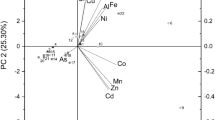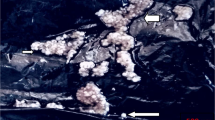Abstract
A 13-week feeding trial was conducted to determine the optimal dietary ascorbic acid (AA) requirement of juvenile spotted rose snapper (Lutjanus guttatus). Six experimental diets containing 0, 7, 19, 29, 62 and 250 mg AA equivalent kg−1 diet, supplied as l-ascorbyl-2-polyphosphate designated as VC0, VC7, VC19, VC29, VC62 and VC250, were fed ad libitum to triplicate groups of 20 juveniles [initial weight (IW) of 8 ± 1.85 g]. Nutrient deficiency resulting in fin erosion, dark skin, desquamation and erratic swimming was observed after 8 weeks in fish fed diets from 0 to 29 mg AA kg−1. Fish that were fed all diets showed gill, kidney and brain alterations. The degree of tissue change values indicates that increasing vitamin C (VC) levels reduces these alterations. Fish fed diets VC29, VC62 and VC 250 showed a significantly higher growth rate in comparison with those fed the diets VC0, VC7 and VC17 (P > 0.05). The dietary requirement of VC in L. guttatus was estimated to be 29 mg kg−1 of AA based on weight gain and specific growth rate, but more than 250 mg kg−1 of AA is required to eliminate clinical signs and histopathological lesions.




Similar content being viewed by others
Abbreviations
- AA:
-
Ascorbic acid
- VC:
-
Vitamin C
- LA2PP:
-
l-Ascorbyl-2-polyphosphate
- DTC:
-
Degree tissue change
- MAV:
-
Mean assessment value
References
Abdo de la Parra MI, Rodríguez-Ibarra E, Hernández C, Hernández K, González-Rodríguez B, Martínez-Rodríguez I, García-Ortega A (2010) Effect of dietary and lipid level on growth performance and survival of juvenile spotted rose snapper Lutjanus guttatus. Rev Biol Mar y Oceanol 45(3):433–439
Adham K, Hashem H, Abu-Shabana M, Kamel A (2000) Vitamin C deficiency in the catfish Clarias gariepinus. Aquac Nutr 6(2):129–139
Aguirre P, Gatlin DM III (1999) Dietary vitamin C of red drum Sciaenops Ocellatus. Aquac Nutr 5:247–249
Ai Q, Mai K, Zhang C, Xu W, Duan Q, Tan B, Liufu Z (2004) Effects of dietary vitamin C on growth and immune response of Japanese seabass, Lateolabrax japonicus. Aquaculture 242:489–500
Ai Q, Mai K, Tan B, Xu W, Zhang C, Ma H, Liufu Z (2006) Effects of dietary vitamin C on survival, growth, and immunity of large yellow croaker, Pseudosciaena crocea. Aquaculture 261:327–336
Alexis M, Karanikolas K, Richards R (1997) Pathological findings owing to the lack of ascorbic acid in cultured gilthead bream (Sparus aurata L.). Aquaculture 152:209–218
Álvarez-Lajonchere L, Puello-Cruz AC (2011) El pargo flamenco: Lutjanus gutattus. Producción controlada de huevos, larvas y juveniles. Centro de Investigación en Alimentación y Desarrollo, Asociación Civil. Unidad Mazatlán en Acuicultura y Manejo Ambiental. AM Editores, México
Alvarez-Lajonchère L, Chávez-Sánchez MC, Abdo de la Parra MI, García-Aguilar N, Ibarra-Castro L, Rodríguez-Ibarra E, Velasco-Blanco G, Fajer-Avila E, Ibarra Soto A (2010) Pilot-scale marine finfish hatchery at Mazatlan, Mexico. World Aquac 14(1):26–29
AOAC (2000) Official methods of analysis of association of official analytical chemists. Association of Official Analytical Chemists, Arlington, p 684
Ashley L, Halver J, Smith R (1975) Ascorbic acid deficiency in rainbow trout and coho salmon and effects on wound healing. In: Ribelin WE, Migaki G (eds) The pathology of fishes. The University of Wisconsin Press, Madison
Avilés-Quevedo A (2006) Engorda de pargo en jaulas flotante. In: Hernández-Martínez M, Rangel-Dávalos, C, Garduño-Dionate M, Mora-Cervantes I (eds) Memorias de la Segunda Reunión Nacional de Red de Cultivo de Peces Marinos, Hermosillo, México, Secretaría de Agricultura, Ganadería, Desarrollo Rural, Pesca y Alimentación, pp 73–79
Avilés-Quevedo A, Mazón-Suástegui JM, Castelló-Orvay F (2008) Avances en el cultivo del pargo flamenco, Lutjanus guttatus: Un ejemplo a seguir de los pescadores de Bahía Concepción, en Baja California Sur. Industria Acuícola 4:4–7
Avilés-Quevedo A, Pérez-Velásquez A, Ramírez-Camarena C, Suárez Higuera L, Márquez García E, Marín Zaldívar LF, Garduño Doniate M, Hernández Martínez M, Barón Campos S, Martínez V (2009) Desarrollo de biotecnología para el cultivo de pargos. http://www.inapesca.gob.mx/portal/sala-de-prensa/boletines/1-desarrollo-de-biotecnologia-para-el-cultivo-de-pargos
Boza-Abarca JE, Calvo-Vargas E, Solis-Ortiz N, Komen J (2008) Desove inducido y crecimiento larval del pargo manchado, Lutjanus gutattus, en la Estación de Biología Marina de Puntarenas, Costa Rica. Ciencias Marinas 34:239–252
Cano A (2003) Reproduction in captivity and cultivation of the Pacific rose spotted snapper in the Republic of Panama. In: Abstracts of the World Aquaculture 2003 Conference, Salvador, Brazil, May 19–23, 2003
Castillo-Vargasmachuca S, Ponce-Palafox JT, Chávez Ortíz E, Arredondo-Figueroa JL (2007) Effect of the initial stocking body weight on growth of spotted rose snapper Lutjanus guttatus (Steindachner, 1869) in marine floating cages. Revista de Biología Marina y Oceanografía 42(3):261–267
Chávez-Sánchez CM, Richards R (1991) Histopathology of vitamin C deficiency in a cichlid, Cichlasoma urophthalmus (Günther). J Fish Dis 14:507–519
Dabrowski K, El-Fiky N, Köck G, Frigg M, Wieser W (1990) Requirement and utilization of ascorbic acid and ascorbic sulphate in juvenile rainbow trout. Aquaculture 91:317–337
Drury RAB, Walington EA (1980) Carleton’s histological techniques, 5th edn. Oxford University Press, Oxford
Eo J, Lee K (2008) Effect of dietary ascorbic acid on growth and non-specific immune responses of tiger puffer, Takifugu rubripes. Fish Shellfish Immunol 25:611–616
FAO (Food and Agriculture Organization of the United Nations) (2007) FISHSTAT Plus: universal software for fishery statistical time series. Ver 2.3.2007
Ferguson WH (ed) (2006) Systemic pathology of fish. A text and atlas of normal tissues in teleosts and their responses in disease, 2nd edn. Scotian Press, London
García-Ortega A, Lazo JP (2004) Marine fish larviculture in Mexico: advances and challenges in nutrition and feeding. In: Cruz-Suarez LE, Ricque-Marie D, Nieto Lopez MG, Villareal D, Scholts U, Gonzalez M (eds) Avances en Nutrición Acuícola VII. Memorias de la VII Conferencia Internacional 16-19 Noviembre, Hermosillo, Sonora, México
Gouillou-Coustans MF, Bergot P, Kaushik SJ (1998) Dietary ascorbic acid needs of common carp (Cyprinus carpio) larvae. Aquaculture 161:453–461
Grünewald R (1993) Ascorbic acid in the brain. Brain Res Rev 18:123–133
Halliwell B, Gutteridge J (1985) Oxygen radicals and the nervous system. Trends Neurosci 8:22–26
Halver JE, Smith RP, Tolbert BM, Baker EM (1975) Utilization of ascorbic acid in fish. Ann NY Acad Sci 258:81–102
Hardie LJ, Fletcher TC, Secombes CJ (1991) The effect of dietary vitamin C on the immune response of the Atlantic salmon (Salmo salar L.). Aquaculture 95:201–214
Henrique MMF, Gomes EF, Gouillou-Coustans MF, Oliva-Teles A, Davies SJ (1998) Influence of supplementation of practical diets with vitamin C on growth and response to hypoxic stress of seabream, Sparus aurata. Aquaculture 61:415–426
Ibarra-Castro L, Alvarez-Lajonchere L (2009) Improved induced-spawning protocol for the spotted rose snapper (Lutjanus guttatus). Isr J Aquac-Bamidgeh 61(2):121–133
Ibarra-Castro L, Alvarez-Lajonchere L (2011) GnRHa-induced multiple spawns and volition spawning of captive spotted rose snapper, Lutjanus guttatus, at Mazatlan, Mexico. J World Aquac Soc 42(4):564–574
Ibarra-Castro L, Duncan NJ (2007) GnRHa-induced spawning of wild caught spotted rose snapper Lutjanus gutattus. Aquaculture 272:737–746
Ibarra-Castro L, García-Gasca A, Hernández R, Duncan L (2008) Ovarian development of the spotted rose snapper (Lutjanus guttatus). Cybium 32(2):237–238
Ibarra-Castro L, Muñoz-Meza LE, Álvarez-Lajonchère L (2012) Studies in egg handling and incubation in the spotted rose snapper Lutjanus guttatus (Pisces Lutjanidae). Hidrobiológica 22(1):49–57
Ibarra-Castro L, Martínez Cordero FJ, Alvarez-Lajonchere L (2013) Financial analysis of pilot-scale egg production of spotted rose snapper, Lutjanus guttatus. Aquac Econ Manag 17(2):171–183
Ibiyo LMO, Atteh JO, Omotosho JS, Madu CT (2007) Vitamin C (ascorbic acid) requirements of Heterobranchus longifilis fingerlings. Afr J Biotech 6(13):1559–1567
Kamonporn T, Supranee C, Temdoung S, Pornlerd C, Somkeat K (1999) Diagnostic procedures for finfish diseases. Aquatic Animal Health Research Institute, Department of Fisheries, Thailand
Lee G, Luna HL (1968) Manual of histologic staining methods of the Armed Forces Institute of Pathology, 3rd edn. The Blackiston Division, Mac Graw-Hill Book Company, New York
Liao ML, Seib PA (1988) Chemistry of L-ascorbic acid related to foods. Food Chem 30:289–312
Lim C, Lovell RT (1978) Pathology of the vitamin C deficiency syndrome in channel cattish (Ictalurus punctatus). J Nutr 108:1137–1146
Lin M, Shiau Y (2005) Dietary L-ascorbic acid affects growth, nonspecific immune responses and disease resistance in juvenile grouper, Epinephelus malabaricus. Aquaculture 244:215–221
Liu R, Plumb A, Guerin M, Lovell TR (1989) Effect of megalevels of dietary vitamin C on the immune response of channel catfish Ictalurus punctatus in ponds. Dis Aquat Org 7:191–194
NRC (2011) Nutrient requirements of fish and shrimp. The National Academies Press, National Research Council of the National Academies, Washington
Olson KR (2002) Gill circulation: regulation of perfusion distribution and metabolism of regulatory molecules. J Exp Zool 293:320–335
Phromkunthong W, Boonyarapalin M, Storch V (1997) Different concentrations of ascorbyl-2-monophosphate-magnesium as dietary sources of vitamin C for seabass, Lates calcarifer. Aquaculture 151:225–243
Poleksić V, Mitrović-Tutundžić V (1994) Fish gills as a monitor of sublethal and chronic effects of pollution. In: Müller R, Lloyd R (eds) Sublethal and chronic effects of pollutants on freshwater fish. Fishing News Books, Oxford
Sandnes K (1991) Vitamin C in fish nutrition. Fisk Dir Ser Ernoering 4:3–32
Schwaiger J, Wanke R, Adam S, Pawert M, Honnen W, Triebskorn R (1997) The use of histopathological indicators to evaluate contaminant-related stress in fish. J Aquat Ecosyst Stress Recov 6:75–86
Silva GA, Martinez CBR (2007) Morphological changes in the kidney of a fish living in an urban stream. Environ Toxicol Pharmacol 23:185–192
Silva-Carrillo Y, Hernández C, Hardy RW, González-Rodríguez B, Castillo-Vargasmachuca S (2012) The effect of substituting fish meal with SBM on growth, feed efficiency, body composition and blood chemistry in juvenile spotted rose snapper Lutjanus guttatus (Steindachner, 1869). Aquaculture 364–365:180–185
Simonato JD, Guedes LBC, Martinez BCR (2008) Biochemical, physiological, and histological changes in the neotropical fish Prochilodus lineatus exposed to diesel oil. Ecotoxicol Environ Saf 69:112–120
Wang X, Kim K, Bau SC (2002) Effect of different dietary levels of L-ascorbyl-2-monophosphate-Ca on growth and tissue vitamin C concentrations in juvenile olive flounder Paralichthys olivaceous (Temminck et Schlegel). Aquac Res 33:261–267
Wang X, Kim K, Sungchul C (2003a) Comparison of L-ascorbyl-2-monophosphate-Ca with L-ascorbyl-2-monophosphate-Na/Ca on growth and tissue ascorbic acid concentrations in Korean rockfish (Sebastes schlegeli). Aquaculture 225:387–395
Wang X, Kim KC, Bai S, Huh M, Cho BY (2003b) Effects of the different levels of dietary vitamin C on growth and tissue ascorbic acid changes in parrot fish (Oplegnathus fasciatus). Aquaculture 215:203–211
Wilson RP, Poe WE, Robinson EH (1989) Evaluation of L-ascorbyl-2-polyphosphate (AsPP) as dietary ascorbic acid source for channel catfish. Aquaculture 81:129–136
Xiao LD, Mai KS, Ai HQ, Xu W, Wang XJ, Zhang WB, Liufu ZG (2010) Dietary ascorbic acid requirement of cobia, Rachycentron canadium Linneaus. Aquac Nutr 16(6):582–589
Acknowledgments
This study was funded by a research grant from the National Council for Science and Technology (CONACyT) of Mexico (Project 82991). This work was performed to fulfil the M.Sc. thesis of Briseida Osuna-Durán. The authors are grateful to Biol. Blanca Rodríguez González for her collaboration in the proximal analysis in the Nutrition Laboratory and M.Sc. Estela Rodríguez Ibarra for assistance with student training for taking care of the experimental fish. We highly appreciate the help of Gemma Franklin in the English revision of the manuscript.
Author information
Authors and Affiliations
Corresponding author
Rights and permissions
About this article
Cite this article
Chávez-Sánchez, M.C., Olvera-Novoa, M.A., Osuna-Durán, B. et al. Ascorbic acid requirement and histopathological changes due to its deficiency in juvenile spotted rose snapper Lutjanus guttatus (Steindachner, 1869). Aquacult Int 22, 1891–1909 (2014). https://doi.org/10.1007/s10499-014-9790-6
Received:
Accepted:
Published:
Issue Date:
DOI: https://doi.org/10.1007/s10499-014-9790-6




